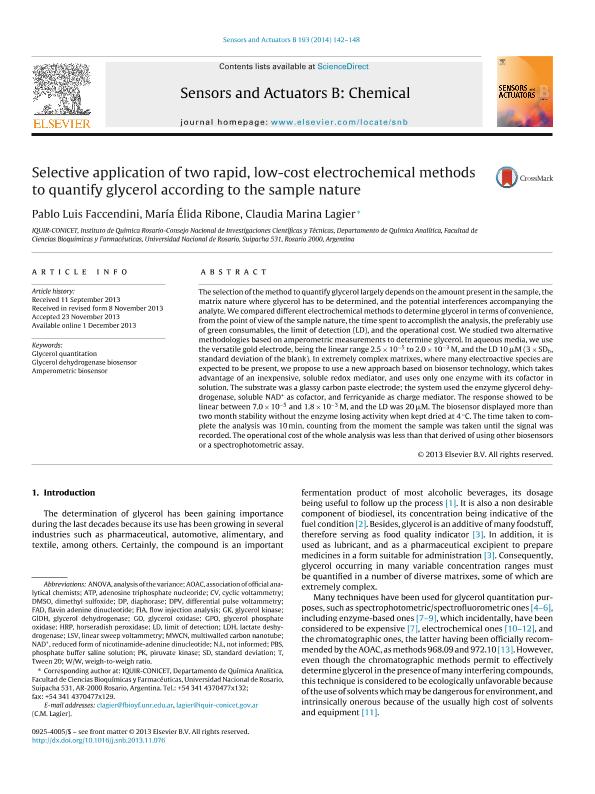Mostrar el registro sencillo del ítem
dc.contributor.author
Faccendini, Pablo Luis

dc.contributor.author
Ribone, María Élida
dc.contributor.author
Lagier, Claudia Marina

dc.date.available
2016-06-02T18:35:54Z
dc.date.issued
2014-02
dc.identifier.citation
Faccendini, Pablo Luis; Ribone, María Élida; Lagier, Claudia Marina; Selective application of two rapid, low-cost electrochemical methods to quantify glycerol according to the sample nature; Elsevier; Sensors and Actuators B: Chemical; 193; 2-2014; 142-148
dc.identifier.issn
0925-4005
dc.identifier.uri
http://hdl.handle.net/11336/6010
dc.description.abstract
The selection of the method to quantify glycerol largely depends on the amount present in the sample, the matrix nature where glycerol has to be determined, and the potential interferences accompanying the analyte. We compared different electrochemical methods to determine glycerol in terms of convenience, from the point of view of the sample nature, the time spent to accomplish the analysis, the preferably use of green consumables, the limit of detection (LD), and the operational cost. We studied two alternative methodologies based on amperometric measurements to determine glycerol. In aqueous media, we use the versatile gold electrode, being the linear range 2.5 × 10−5 to 2.0 × 10−3 M, and the LD 10 μM (3 × SDb, standard deviation of the blank). In extremely complex matrixes, where many electroactive species are expected to be present, we propose to use a new approach based on biosensor technology, which takes advantage of an inexpensive, soluble redox mediator, and uses only one enzyme with its cofactor in solution. The substrate was a glassy carbon paste electrode; the system used the enzyme glycerol dehydrogenase, soluble NAD+ as cofactor, and ferricyanide as charge mediator. The response showed to be linear between 7.0 × 10−5 and 1.8 × 10−3 M, and the LD was 20 μM. The biosensor displayed more than two month stability without the enzyme losing activity when kept dried at 4 °C. The time taken to complete the analysis was 10 min, counting from the moment the sample was taken until the signal was recorded. The operational cost of the whole analysis was less than that derived of using other biosensors or a spectrophotometric assay.
dc.format
application/pdf
dc.language.iso
eng
dc.publisher
Elsevier

dc.rights
info:eu-repo/semantics/openAccess
dc.rights.uri
https://creativecommons.org/licenses/by-nc-nd/2.5/ar/
dc.subject
Biosensores
dc.subject
Glicerol
dc.subject
Amperometría
dc.subject.classification
Química Analítica

dc.subject.classification
Ciencias Químicas

dc.subject.classification
CIENCIAS NATURALES Y EXACTAS

dc.title
Selective application of two rapid, low-cost electrochemical methods to quantify glycerol according to the sample nature
dc.type
info:eu-repo/semantics/article
dc.type
info:ar-repo/semantics/artículo
dc.type
info:eu-repo/semantics/publishedVersion
dc.date.updated
2016-06-01T13:36:23Z
dc.journal.volume
193
dc.journal.pagination
142-148
dc.journal.pais
Países Bajos

dc.journal.ciudad
Amsterdam
dc.description.fil
Fil: Faccendini, Pablo Luis. Consejo Nacional de Investigaciones Científicas y Técnicas. Centro Científico Tecnológico Rosario. Instituto de Química Rosario; Argentina
dc.description.fil
Fil: Ribone, María Élida. Consejo Nacional de Investigaciones Científicas y Técnicas. Centro Científico Tecnológico Rosario. Instituto de Química Rosario; Argentina
dc.description.fil
Fil: Lagier, Claudia Marina. Consejo Nacional de Investigaciones Científicas y Técnicas. Centro Científico Tecnológico Rosario. Instituto de Química Rosario; Argentina
dc.journal.title
Sensors and Actuators B: Chemical

dc.relation.alternativeid
info:eu-repo/semantics/altIdentifier/url/http://www.sciencedirect.com/science/article/pii/S0925400513014263
dc.relation.alternativeid
info:eu-repo/semantics/altIdentifier/doi/http://dx.doi.org/10.1016/j.snb.2013.11.076
dc.relation.alternativeid
info:eu-repo/semantics/altIdentifier/doi/10.1016/j.snb.2013.11.076
Archivos asociados
